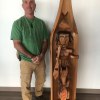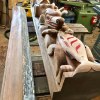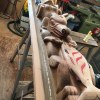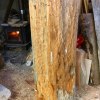Hiłḥiyiis
Redcedar / Abalone / Deer Antler
Hiłḥiyiis is a carving that was commissioned by the Clayoquot Biosphere Trust to reflect the Hišinqʷiił regional gathering of September 17, 2017. Much of the focus that day was on reconciliation, bringing together people from all 7 west coast communities to share in food, company and presentations reflective of who we are.
Hiłḥiyiis means “standing on the shoulders of”. The woman figure represents all of us as residents of the west coast communities; the wolf represents the Nuu-chah-nulth ancestors. We are all standing on the shoulders of the ancestors of these lands. The name comes from the Frank family in Ahousaht and I am using it here with permission from my brother and elder, David Frank Sr.
The Qʷayac̓iik (wolf), the ancestors, are the foundation for this carving, the base of the totem pole, holding all things up. The Qʷayac̓iik speaks to natural law - respect for nature, ourselves and each other. Qʷayac̓iik is holding a Salmon to remind us of the interconnectedness of all things and of our responsibilities to take care of the environment and all that nourishes us.
The human figure is portrayed as a woman to represent future leadership. She has a voice symbolized by the abalone shell on her throat. We need to listen to this voice, it has been silenced for too long. Her eyes, as painted by Deanna Lankin, represent all cultures. In one hand, she is holding a paddle to represent the tools we possess for moving ahead in life. Her other hand is holding the gunnels of the canoe to show leadership steadying the boat as we navigate the waters ahead.
Nuu-Cha-Nulth teachings use the Čapac (canoe) as an analogy for our lives. We choose what goes in and and out of our canoes, if we are living in balance. In the absence of balance we lose control and choice. This Čapac is formed in the ƛaʔuukʷiatḥ (Tla-o-qui-aht) style of the Martin family. The roughed out prow and technical advice was provided by Joe Martin. All the figures are inside the Čapac to represent the fact that as residents of the west coast we are all in the same boat.
Lastly the paddle has 7 abalone shells for each community. There is an Eagle carved on the paddle to represent vision. The gifts of the Eagle spirit are to see from above, the big picture, but also to be brave and use that vision to look deep within ourselves to affect humility, personal growth and change.
I am not the inventor of all of these concepts. I am practicing what reconciliation means to me, in part, to be a good listener. We all have to reconcile our right to belonging.
Robinson Cook Seoptember 2018




